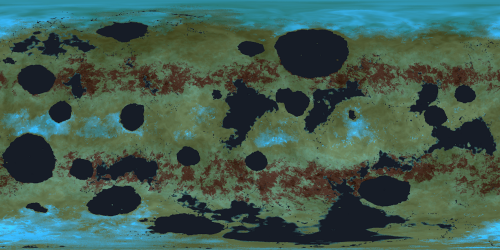Calypso
Calypso is an aquaric world in the Proxima Centauri star system, orbiting the ice giant Atlas. It is a cold world with a liquid solvent cycle of ammonia, which pool in the ancient craters on the surface. Calypso hosts a thriving biosphere of methane-hydrogen metabolizing organisms, among them a sophont species capable of interstellar spaceflight: Calypsians.
Humans' first crewed surface mission to Calypso was the Arete Mission in 2181-2205 CE, which had no direct successors.
Geography
Location
Calypso is the sixth and largest moon of the ice giant Atlas, the third planet in the Proxima Centauri system. Its exterior orbital neighbor is the slightly smaller Antheia, which also has liquid ammonia on its surface; its interior neighbor is the much smaller, arid Tara. Calypso's orbit is mostly outside of Atlas' strong magnetic field, but the moon has its own magnetic field produced in its metallic core by tidal forces.Surface
Ecosystem
Calypso is home to the Calypsigenid group of organisms, which are primarily characterized by their mixed carbon-silicon biochemical basis and the methane-hydrogen metabolic cycle, which parallels the more common CO2-oxygen cycle. Calypso's dominant clade of photoautotrophs, or "floralogues," utilize the limited light energy of Proxima Centauri to react atmospheric methane with water absorbed from the ground, forming various carbohydrate molecules for energy storage and biomass-building and dispersing the excess hydrogen gas. Because Calypso is tidally locked to its planetary parent, each hemisphere spends nearly two weeks in darkness, leading the floralogues to develop controlled biophosphorescence that utilizes the excess ultraviolet energy absorbed during the day period to extend their photosynthesis into the dark period. The heterotrophic organisms ("faunalogues") of Calypso consume and store the carbohydrates produced by the floralogues and release their energy by reacting them with hydrogen, exhaling methane and water vapor. Because Calypso is a dimly-lit world even during the day period, most Calypsian organisms sense the world primarily through infrared and/or sound, culminating in a form of biosonar that is widespread among the Calypsian faunalogues. Among these faunalogues is a single sophont species: the Calypsians.Calypsigenid Life
Chemistry
- Hydrogen
- Oxygen
- Nitrogen
- Phosphorous
- Sulfur
Genetics
- Diaminopyramidine
- Xanthine
- Thymine
- Diaminopurine
- Adenosine
Metabolics
Structure
Base unit is a silicone-siloxane bilayer cell with internal components in ammonia-based fluid suspension. Genetic material is contained within the cell in open suspension, in compact form with organelles to unpack sections in use.Maps
-
Calypso
Calypso is an aquaria-class world in the Proxima Centauri star system, and the homeworld of the Calypsian.
Archive Data
- 82.1% N2
- 17.5% H2
- 1.3% CH4
- >0.1% other gases




Comments